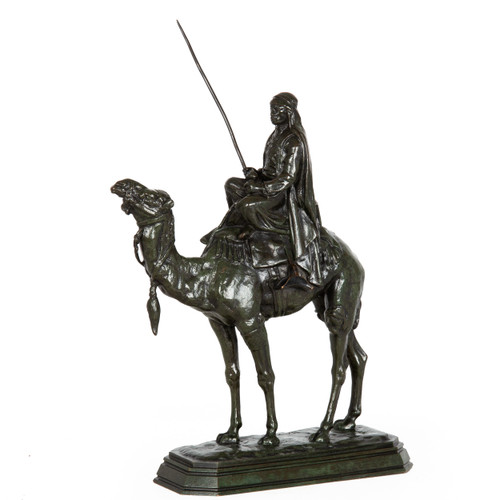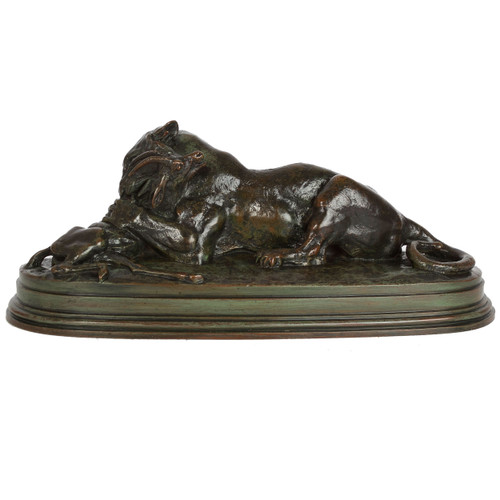-

-

-

-

-

Barye, Antoine-Louis
"Lion Assis no. 2" | Antoine-Louis Barye & Delafontaine
Regular: $11,800.00Special Price: $9,500.00 -
!["Lion Assis no. 4" | Antoine-Louis Barye [after] "Lion Assis no. 4" | Antoine-Louis Barye [after]](https://cdn11.bigcommerce.com/s-rw7pdzyh/images/stencil/500x659/products/2929/87511/MAIN__02225.1653057946.jpg?c=2)
-

Barye, Antoine-Louis
"Walking Leopard", bas-relief plaque | after Antoine-Louis Barye
Regular Price: $1,550.00 -

Barye, Antoine-Louis
"Tigre Devorant une Gazelle" | Antoine-Louis Barye & Barbedienne
Regular Price: $8,300.00 -

Barye, Antoine-Louis
"Lion du Zodiaque" (Lion of the July Column) | Antoine Louis Barye
Regular: $13,000.00Special Price: $9,100.00 -

-

Barye, Antoine-Louis
"Panthere de Tunis" | Antoine-Louis Barye
Regular: $7,300.00Special Price: $5,750.00
Barye, Antoine-Louis

Antoine-Louis Baryé was born in September of 1796 to Pierre Baryé, a goldsmith in Paris. After leaving the military in 1816, Baryé studied under classical sculptor Bosio, working in the studio of painter Gros in 1817 and was accepted in the Ecole des Beaux-Arts in 1818. Passionate about animal subjects, Baryé studied them in a level of depth that was uncommon, approaching his subjects scientifically. He spent hours making anatomical studies in dissecting rooms, the Musée d’Histoire Naturelle, and at the Jardin des Plantes where he watched living animals move in their natural habitats. Every aspect of the animal fascinated him, including their mannerisms, behaviors and biological makeup. Rather than imparting human emotions to his subjects, the depth of his study resulted in works that truly captured the energy of the beast, conveying the wild and highly individualistic personality of each species.
By no means an immediate success, Baryé sculpted and exhibited extensively with little recognition. After many years of failure, he stopped exhibiting for a period and in 1823 took up employment with goldsmith Fauconnier for eight years, effectively abandoning the Beaux Arts until 1827 when he began exhibiting again. It wasn’t until he presented “Tigre Deviant Un Gavia” at the Salon in Paris 1831 that his work received significant notice. He left employment with Fauconnier and focused himself entirely on his art. Starting in 1838, Baryé began casting his own works, prior to that relying on Honoré Gonon for the majority of foundry work. Meticulous in his attention to detail, he is noted as regularly rejecting beautiful works that had even a minor flaw, generally insisting on sculptures leaving his foundry being numbered - so involved in the foundry process was Baryé that he became a licensed bronzier in 1839 and is noted as being involved even in the chasing and application of patinas on his works. Failure was never far from his door, Baryé declared bankruptcy in 1848, at which point his works were cast by the Ferdinand Barbedienne foundry for at least the next ten years as he remained under the burden of debt. After his death in 1875, rights to much of his work was purchased by Barbedienne who subsequently put forth one hundred and twenty of these in their 1887 catalogue. While his work was of significance in it’s own right, raw and powerful with a naturalism that was ignored in preference of romance, of even greater significance is the impact he had on his contemporaries and generations of sculptors to follow. He initiated a movement of “Animalier” sculptors that, though of small membership and output, became an important and prominent niche in nineteenth century art.
Literature:
- Barye: Catalogue Raisonné des Sculptures, Poletti & Richarme
- The Barye Bronzes, A Catalogue Raisonné, Stuart Pivar
- The Founders and Editors of the Barye Bronzes, J. G. Reinis
- Animals in Bronze, Christopher Payne
- Bronze Sculpture of “Les Animaliers”, Jane Horswell
- Bronzes of the Nineteenth Century: Dictionary of Sculptors,Pierre Kjellberg
- Bronzes by Antoine-Louis Barye, Parke-Bernet Galleries, The Bernard Black-Hugues Nadeau Collection
- Antoine-Louis Barye, Sculptor of Romantic Realism, Glenn F. Benge
- The Animaliers, James Mackay, p. 20-38
- L'oeuvre de Barye, Roger Ballu
